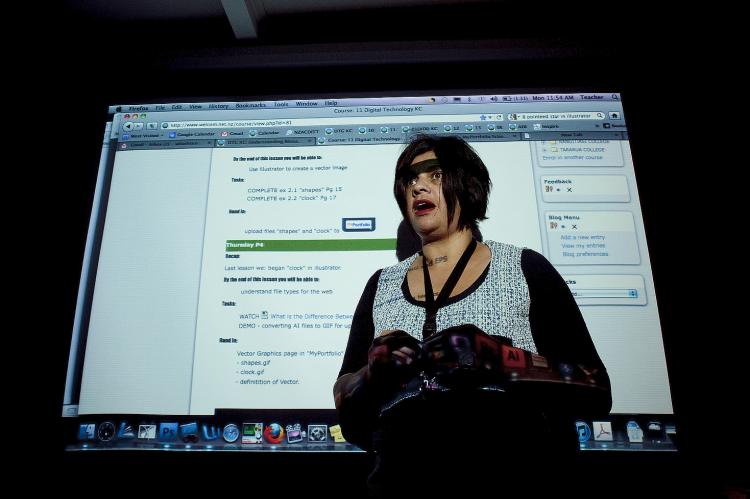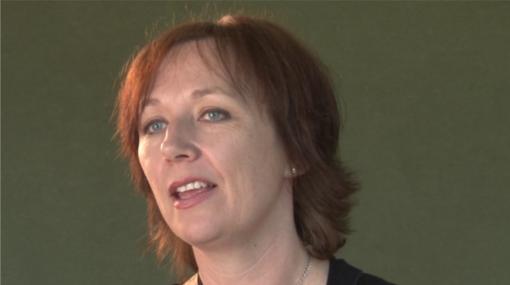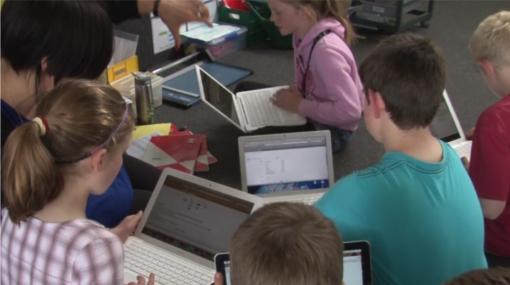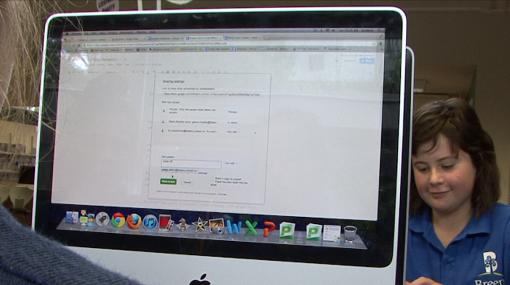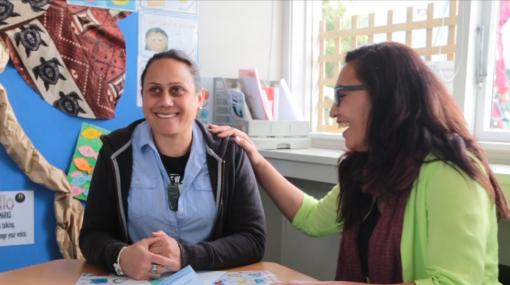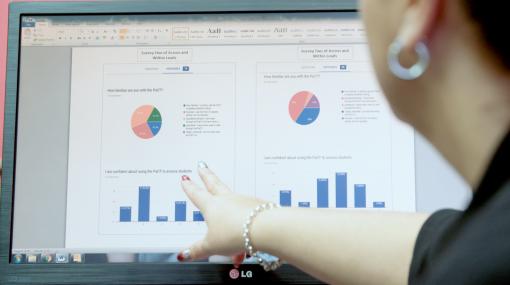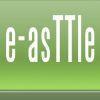Assessment and e-learning tools
Assessment and e-learning
e-Learning tools enable you to easily gather and share assessment information in ways that advance the learning of students.
Digital devices enable reflection not previously possible because of the ability to capture and replay learning. Because of the portability and immediacy of the replay, assessment and planning for improvement can happen quickly. When this reflection and learning has meaning for students, the process has potential to shift learning and create lasting and transformative change.
Digital technologies can remove barriers and provide options for assessment
You can digital technologies to remove barriers and provide alternatives for students to share or demonstrate their learning, for example:
- reduce the barrier of reading and writing by making applications such as text-to-speech available
- provide options for students to present their learning using multimedia rather than only in written form.
Involve students in identifying the supports they need. Provide options for students to select what works best for them.
How do you use technologies for assessment?
Use these discussion starters in conjunction with the e-Learning Planning Framework to reflect on how you use technologies in your assessment processes and identify opportunities to improve your practice to meet the needs of all learners.
Principals and school leaders
- To what extent does your school adopt broad, differentiated assessments to ensure success for all students?
- How can technologies be used to record, analyse, and report on student progress and performance in all aspects of the curriculum over time?
- How are you using digital technologies to engage parents as partners in learning?
- How does your school use technologies to engage with and report progress to the wider community?
Teachers
- What might it look like when students are using technologies to manage and reflect on their own learning?
- How could you use technologies to monitor and share students learning and progress?
- How can you use technologies to support parents/caregivers/whānau to interact with their children’s learning?
- What achievement data is gathered, and analysed to inform planning and teacher inquiry so that the needs of all your learners are met – including your and Māori, Pacific Island students, and those with additional learning needs?
Practical steps for integrating technologies into your classroom assessment processes
Use these practical steps in conjunction with the e-Learning Planning Framework , which will help you identify where you are at and where to next.
- Plan a teacher inquiry to trial and develop successful ways of using digital technologies.
- Build your understanding of how digital technologies can be used to collect evidence, self reflection, and assessment progress.
- Focus on setting up systems and using digital technologies so learners can:
- show how they are learning
- show what they know or can do rather than what they can’t
- become self-regulated learners and determine their own learning goals and plans
- establish what they already know, assess their strengths and weaknesses, to co-construct and design a learning plan
- stay on task, track their own progress, build on successes, and adjust to failures.
- explore using technologies enable all students to participate equitably in assessments, for example using text-to-speech, screen readers.
- Share examples of effective practice with colleagues and the wider community.
Teacher inquiries into using Google docs from CORE Ministry Video on Vimeo.
Mike Wilson, ICT Cluster Director at Sacred Heart Girls’ College, describes the benefits teachers found from inquiring into using Google docs and Google forms. They are using these tools with students to provide quick feedback as they prepare for NCEA assessments.
More information »
- Teacher standards: Design for learning – Information and examples of e-learning tools, which can be used to gather and use assessment information in ways that advance the learning of your ākonga/students.
- School stories and Snapshots of learning tabs on this page
Involving parents, whanāu and the wider community
Communicating clear, dependable information about progress and achievement provides a basis for building a strong partnership between the child, the teacher, and the child’s parents and family/whānau.
Parents and whānau are a student's first and most important teachers. Building learning-focussed relationships and connections between parents, whānau, and teachers is vital for ongoing learning and success. Ākonga ( are the core participants in any learning environment and they need to be actively engaged in understanding their own actions and progress as learners.
Students at Motu School use e-portfolios for goal setting, sharing their learning, and reflecting on their progress. Students lead the three way conferences with parents and teachers, using the e-portfolios to share and explain their learning. This process means conversations about learning are more focused. Students value parent feedback and engagement in their learning. Having the portfolios online means parents can access and be part of their children's learning at anytime.
Digital tools allow the student, teacher and parents to share the learning process as each participant can contribute in real time to enhance current learning while also promoting further learning. A digital kete or e-portfolio will enhance: partnerships in learning, learning conversations, self-regulation, feedback, engagement, and assessment as learning. Using a digital kete or e-portfolio to track learning journeys supports formative assessment to improve future learning outcomes, is personalised with the students’ own voice and meets reporting requirements.
Using e-portfolios
An e-portfolio is an electronic format for learners to record their work, their achievements and goals, to reflect on their learning, and to share and be supported in this process. It enables learners to represent information in different formats and to take the information with them between institutions.
Assessment of learning
e-Portfolios can be a digital platform for information collected throughout a designated time period that can be used as summative assessment.
Assessment for learning
e-Portfolios offer functionality for instant and formative feedback on learning activities, informing the direction of learning for both teacher and learner.
Assessment as learning
A learner can use an e-portfolio for personal reflection, to help them to become aware of their own learning habits and identify strategies to assist with their learning needs.
More information »
- Using e-portfolios in the classroom – Information and practical examples to help you get started with e-portfolios – including the different technologies you can use, and how to implement their use.
- Reporting to parents and whānau – Up-to-date resources supporting schools to share information with parents and whānau from Assessment online.
Curriculum Progress Tools – PaCT and the Learning Progression Frameworks
The curriculum progress tools website houses the Learning Progression Frameworks (LPFs) and the Progress and Consistency Tool (PaCT)work. It contains support for teachers and updates on the tools.
Progress and consistency tool (PaCT)
The Progress and Consistency Tool (PaCT) and Te Waharoa Ararau (TWA) are online tools that support teaching and learning. They are designed to help teachers make consistent overall teacher judgements in reading, writing, and maths.
The progress tools align judgments to the curriculum levels of The New Zealand Curriculum and Te Marautanga o Aotearoa respectively. They include levels 1-5+ of the curriculum. The tool is designed to make students’ progress and achievement in relation to curriculum more visible, putting teachers in a stronger position to support ākonga progress.
The PaCT helps teachers by:
- providing a rubric for assessing students
- keeping track of student achievement data
- creating informative reports that illustrate student, class, school, and Kāhui Ako progress; and provide feedback to parents and whānau
- streamlining paperwork and reducing reporting workload.
Features of the tool
- Expected curriculum progress: This shows the progress expected through levels 1 to 5 of the curriculum. It is based on the expectation that students will take two years of schooling to move through each level of the NZC. It provides a visual trajectory for expected achievement and appropriate rates of progress in relation to the demands of the curriculum.
- Typical progress: This shows the achievement of the middle 50% of students (between the 25th and 75th percentiles). It is based on data collected within PaCT. It shows student achievement in relation to the wider population.
- Progress trend: This shows what the student’s expected rate of progress will be over the next 12 months, if learning conditions are unchanged. It is based on the student’s achievement over the previous 14 months.
- Progress narratives: Concise general descriptions, which summarise what students can usually do when they achieve at different stages of the New Zealand Curriculum levels (this is shown on the PaCT scale).
Progress reports can be tailored and used for teaching and learning including conversations with students, parents, and whānau.
The PaCT is underpinned by the Learning Progression Frameworks (LPF) .
The learning progression frameworks tool
The LPF is an online tool that illustrates the significant steps students take as they develop their expertise in reading, writing, and mathematics from years 1–10, spanning levels 1–5 of The New Zealand Curriculum (NZC).
The frameworks:
- prompt teachers to notice what students know and can do across the breadth of mathematics and as they use their reading and writing to support their learning in different areas of the curriculum
- support teachers to understand how students develop their expertise in reading, writing, and mathematics
- assist teachers to identify the reading, writing, and mathematics demands of the programmes they provide for students
- clarify the reading, writing, and mathematics competencies students require in order to be successful in a technology- and information-rich society
- illustrate rich teaching and learning activities in everyday classroom programmes
- support schools to plan coherent learning pathways for students transitioning across school contexts.
NCEA Assessment online
NZQA is transforming the way National Certificate of Educational Achievement (NCEA) external assessment is offered.
The move to digital assessment provides an opportunity to:
- take advantage of 21st century innovative teaching and learning approaches
- improve the equity of NCEA outcomes for Māori and Pasifika students through, for example, access to richer data available about their experience and different ways for capturing student responses.
This approach to assessment supports innovation in teaching and learning. Students will be able to show their skills in different ways such as oral responses, simulation, and gamification. These assessment options have the potential to engage more students in ways that are meaningful, authentic and relevant to their individual needs and their culture.
Preparing your students for digital exams
Prepare students from year 9 for doing digital exams. To build appropriate skills, they should:
- use devices on a regular basis
- be competent at reading and writing online
- take the opportunity to practice with tools provided when online assessments are created.
Identify supports students may need:
- Do they need tools such as a screen reader or text-to-speech to support them with reading and writing online?
- Are students competent at typing? Do they need practice with keyboard skills?
- Do they know how to alter the size of font on the screen to make it easier to read?
More information »
Snapshots of learning
These snapshots are selection of examples of effective classroom practice in NZ describing the use of digital technologies for assessment.
Personalised assessment practices in a secondary context
In order to make learning more meaningful, teacher Gareth Manins, from Cambridge High School, personalised learning in literacy for his year 11 students by making shifts from "assessment driven" to "learner focussed lessons", and from "teacher in charge" to "student in control".
Key resource
Tāhūrangi - Assessment Tools and Resources
This section of Tāhūrangi This section contains different approaches to understanding learning progress.
Teacher standards: Design for learning
Information and examples of e-learning tools, which can be used to gather and use assessment information in ways that advance the learning of your ākonga/students.
This rubric helps schools and teachers evaluate how well they are progressing in relation to Māori learner progress and achievement, including proficiency in te reo Māori.
Strategies and approaches for using technologies to provide inclusive and personalised learning pathways. This online guide includes a strategy to Support assessment and exams, including NCEA
PATs, STAR, and Science: Thinking with evidence available as online tests
Students can sit NZCER tests online. All PATs, STAR, and Science: Thinking with evidence tests can be taken through an attractive, easy-to-use online platform. Teachers can trial all of the online assessments.
In this online computer adaptive version of a PAT: Mathematics test, the computer selects the questions for each student based on the responses they have given to previous questions in the test. Students who struggle to answer the initial questions correctly are given easier questions until they begin to have some success. Students who do answer the initial questions correctly are given progressively harder questions until they start to answer some of them incorrectly. PAT: Mathematics Adaptive administers tests that are tailored to each individual student. An adaptive test will generally provide a more precise result for each student in a group than using one of the existing static PAT: Mathematics tests. In an adaptive test, the computer also makes sure that the questions being administered cover the normal range of mathematical topics assessed by PAT: Mathematics in the right proportions (number knowledge, number strategies, algebra, geometry and measurement, and statistics). The adaptive tests are suitable for students in Year 4 to Year 10. Students should be confident using a computer to complete a test.
PAT: Reading vocabulary adaptive
In this online computer adaptive version of PAT: Reading Vocabulary Adaptive, tests are tailored to each individual student. Because the tests are well targeted in terms of difficulty level, an adaptive test will generally provide a more precise result for each student in a group than using one of the existing static PAT: Reading Vocabulary tests. The adaptive tests are suitable for students in Year 4 to Year 10. Students should be confident using a computer to complete a test.
The ARBs consist of 1246 assessment resources in English, Mathematics, and Science. These are for students working at levels 2–5 in New Zealand classrooms. NZCER have re-developed 150 resources into an interactive online format. Register for access on the ARBs registration page .
Progress and Consistency Tool (PaCT)
The progress and consistency tool supports teachers' professional judgments for mathematics, reading, and writing to improve the measurement of learner progress over time.
Tāhūrangi – Reporting to parents and whānau
Find up-to-date resources that support schools to share information with parents and whānau.
Tāhūrangi - e-asTTle overview and access
e-asTTle is an online assessment tool, developed to assess students’ achievement and progress in reading, mathematics, writing, and in pānui, pāngarau, and tuhituhi.
This section of the e-asTTle collection provides a detailed overview of e-asTTle as an online assessment tool, including information on the various roles and how to access the tool.
A training webinar on the revised e-asTTle writing tool is available on Assessment Online. It is facilitated by the developers of the revised writing tool. It covers the new features of the tool, test creation, administration and marking, and how to best use the results to support teaching and learning.
Monitoring the Key Competencies
Useful information and discussion tools to assist with monitoring the key competencies on the TKI Key Competencies website.
eLearning ICT Showcases l Learning, Teaching & Assessment, Reporting
Information and resources on how schools lead, enable, and support the use of ICT to transform learning and teaching, and improve learning outcomes. This includes: curriculum planning, delivery, student ICT capabilities, ICT ethics, assessment and reporting, and reporting to parents. A webpage from the Department of Education and Early Childhood Development in Victoria, Australia.
Research and readings
Raising student achievement through targeted actions (2015)
This ERO report summarises the national picture for targeted actions in our schools and provides examples from the schools successfully setting targets and taking actions that raised student achievement.
Preparing for a renaissance in assessment
(2014)
In this article Sir Michael Barber (Pearson’s Chief Education Advisor) and assessment expert, Dr Peter Hill argue that current assessment methods are no longer working and new technologies will transform assessment and testing in education. It itemises steps in a "Framework for Action" that policymakers, schools, school-system leaders, and other key players use to prepare for the assessment renaissance.
